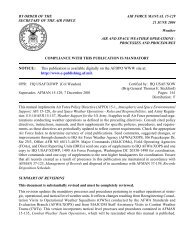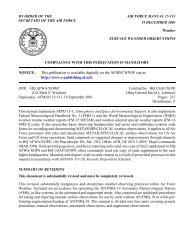Joint Metoc Handboo - IHMC Ontology and Policy Management
Joint Metoc Handboo - IHMC Ontology and Policy Management
Joint Metoc Handboo - IHMC Ontology and Policy Management
Create successful ePaper yourself
Turn your PDF publications into a flip-book with our unique Google optimized e-Paper software.
3-JTF HQ METOC Support<br />
management <strong>and</strong> storage, information management, computers, communications,<br />
applications, security, people, training, <strong>and</strong> support. The DII is managed by the<br />
Defense Information Systems Agency (DISA) under the sponsorship of the <strong>Joint</strong> Staff.<br />
The DII architecture encompasses the <strong>Joint</strong> Technical Architecture (JTA), DII<br />
Common Operating Environment (COE), DISN, GCCS, <strong>and</strong> GCSS. The <strong>Joint</strong><br />
Technical Architecture (JTA) m<strong>and</strong>ates the technical st<strong>and</strong>ards <strong>and</strong> specifications<br />
required for interoperability among systems within the DII. The DII COE provides an<br />
open systems development <strong>and</strong> operating environment for information systems within<br />
the DII. The Global Comm<strong>and</strong> <strong>and</strong> Control System (GCCS) <strong>and</strong> Global Combat<br />
Support System (GCSS) are systems within the DII COE. The Defense Information<br />
System Network (DISN) is the global telecommunications infrastructure that provides<br />
end-to-end information transfer <strong>and</strong> value-added network services. The DISN<br />
architecture provides an integrated network service to meet all DoD requirements for<br />
voice, video, <strong>and</strong> data communications. The DISN includes the Secure Internet<br />
Protocol Router Network (SIPRNET).<br />
• Global Comm<strong>and</strong> <strong>and</strong> Control System (GCCS). The GCCS is a global C4I system that<br />
is robust, reliable, interoperable, secure, responsive, <strong>and</strong> survivable. It presents<br />
essential information to the warrior whenever <strong>and</strong> wherever the warrior directs. It<br />
enables the warrior to synchronize actions. The following general description is from<br />
the <strong>Joint</strong> Staff J6 <strong>Joint</strong> C4 systems description document. The GCCS:<br />
- Provides a fused, near real-time, true picture of the battlespace<br />
- Provides open, modern, client-server systems<br />
- Provides real-time battlefield awareness to comm<strong>and</strong>ers<br />
- Uses sensor, intelligence, <strong>and</strong> plans data as principal input<br />
- Uses an evolutionary acquisition strategy<br />
- Has core functions, to include: crisis planning, force deployment, force status, air<br />
operations, intelligence, message h<strong>and</strong>ling capability, METOC <strong>and</strong> narrative<br />
information<br />
- Consists of three elements: core common software, common st<strong>and</strong>ards, <strong>and</strong> CINC<br />
unique software<br />
- Composed of ongoing service C4I modernization programs<br />
- GCCS METOC Applications. With DISA’s fielding of the <strong>Joint</strong> METOC Segments<br />
(JMS) <strong>and</strong> Tactical Forecast System (TFS) in GCCS 3.0, the first METOC<br />
segments are available within the DII COE for use by joint METOC personnel.<br />
These segments ingest gridded, observational <strong>and</strong> imagery data for processing <strong>and</strong><br />
display in the joint mapping <strong>and</strong> visualization segment. The significance of these<br />
segments is twofold: first, the segments provide systems (e.g., GCCS) within the<br />
DII COE the capability to display METOC products in the situational awareness<br />
picture. Secondly, the Applications Programming Interfaces (APIs) used by the<br />
segments are available to other segment developers so that METOC data can be<br />
fully integrated in mission support applications (e.g., satellite vulnerability, joint air<br />
defense planning, UAV mission planning). The APIs are based on WMO<br />
communications formats for binary data exchange (GRIB <strong>and</strong> BUFR). These<br />
3-9




